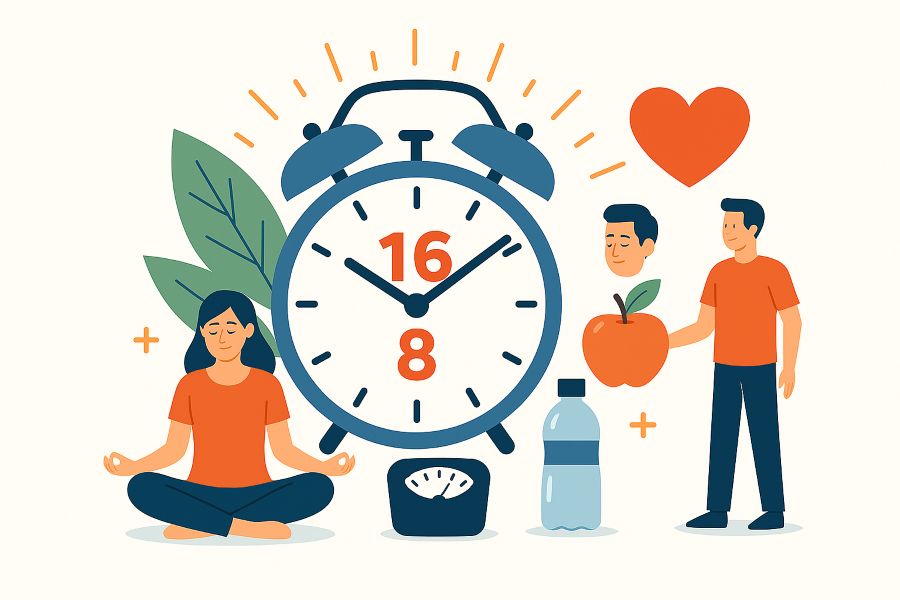Have you ever wondered if there’s a simple, sustainable way to boost your health, shed some extra pounds, and feel more energized without following a restrictive diet? Enter the 16/8 fasting method, a popular form of intermittent fasting that’s taken the wellness world by storm. This approach isn’t about starving yourself or cutting out entire food groups; it’s about timing your meals to align with your body’s natural rhythms. In this comprehensive guide, we’ll dive deep into what 16/8 fasting is, how it works, the science behind its benefits, and practical tips to help you get started. Whether you’re a beginner or a seasoned faster, this post will equip you with everything you need to succeed on your intermittent fasting journey.
What Is 16/8 Fasting?
At its core, 16/8 fasting is a type of intermittent fasting (IF) that involves cycling between periods of eating and fasting. The name itself gives you a clue: you fast for 16 hours each day and eat during an 8-hour window. For example, you might eat between 12 PM and 8 PM, then fast from 8 PM until 12 PM the next day. This method is incredibly flexible, making it one of the most beginner-friendly approaches to intermittent fasting. Unlike other fasting protocols, 16/8 doesn’t dictate what you eat—only when. This means you can pair it with various dietary preferences, whether you’re keto, vegan, or just eating a balanced diet. The simplicity of the 16/8 method is what makes it so appealing for those looking to improve their health without overcomplicating their routine.
The Science Behind 16/8 Fasting
So, why does 16/8 intermittent fasting work? The magic lies in how fasting impacts your body on a cellular and hormonal level. During the fasting period, your insulin levels drop, which facilitates fat burning as your body switches to using stored energy (like glycogen and fat) for fuel. Additionally, fasting triggers a process called autophagy, where your cells clean out damaged components and regenerate—a bit like a cellular detox. Studies have shown that intermittent fasting methods like 16/8 can improve metabolic health, reduce inflammation, and even enhance brain function. For instance, research published in the journal Obesity found that participants practicing 16/8 fasting experienced significant weight loss and improved insulin sensitivity over several weeks. While it’s not a cure-all, the science suggests that this fasting schedule can be a powerful tool for overall wellness.
Key Benefits of 16/8 Fasting
The 16/8 fasting method offers a range of benefits that go beyond just weight loss. While shedding pounds is often the primary goal for many, this approach can positively impact various aspects of your health. Here are some of the top advantages backed by science and real-world experiences:
- Weight Loss: By reducing your eating window, you’re likely to consume fewer calories naturally, creating a calorie deficit without feeling deprived.
- Improved Metabolic Health: Fasting helps regulate blood sugar levels and improves insulin sensitivity, which can lower the risk of type 2 diabetes.
- Enhanced Mental Clarity: Many fasters report better focus and productivity during fasting hours, possibly due to stabilized energy levels.
- Simplified Eating Habits: With fewer hours to eat, meal planning becomes easier, and mindless snacking is reduced.
How to Start 16/8 Fasting: A Step-by-Step Guide
Getting started with 16/8 fasting for beginners doesn’t have to be intimidating. The key is to ease into it and find a schedule that fits your lifestyle. Here’s a practical roadmap to help you begin your intermittent fasting journey with confidence. First, choose your eating window—most people find 12 PM to 8 PM convenient since it aligns with typical meal times and allows for social eating in the evening. During the fasting period, you can drink water, black coffee, or unsweetened tea to stay hydrated and curb hunger. Start with a few days a week rather than diving into a daily routine, and listen to your body. If you feel overly hungry or fatigued, adjust your window or consult a healthcare professional. Remember, consistency matters more than perfection when it comes to 16/8 fasting results.
Tips for Success with 16/8 Fasting
While the 16/8 fasting schedule is straightforward, a few strategies can make the experience smoother and more effective. It’s all about setting yourself up for success by anticipating challenges and planning ahead. Below are some actionable tips to help you stick to your fasting goals and maximize the benefits:
- Stay Hydrated: Drink plenty of water during fasting hours to prevent dehydration and reduce hunger pangs.
- Focus on Nutrient-Dense Foods: During your eating window, prioritize protein, healthy fats, and fiber to keep you full and energized.
- Avoid Overeating: It’s tempting to overindulge after fasting, but aim for balanced meals to avoid digestive discomfort.
- Be Flexible: If a special event falls outside your eating window, adjust your schedule temporarily—life happens!
- Track Progress: Use a journal or app to monitor how you feel, your energy levels, and any weight loss or health improvements.
Who Should Avoid 16/8 Fasting?
While 16/8 fasting benefits are impressive for many, it’s not suitable for everyone. Certain individuals should approach intermittent fasting with caution or avoid it altogether. If you’re pregnant, breastfeeding, or have a history of eating disorders, fasting could pose risks to your health. People with medical conditions like diabetes or low blood pressure should consult a doctor before starting a 16/8 fasting plan, as it may interfere with medications or blood sugar management. Additionally, if you’re underweight or prone to extreme fatigue, fasting might not be the best fit. Always prioritize your well-being and seek personalized advice from a healthcare provider if you’re unsure whether intermittent fasting aligns with your health needs.
In conclusion, the 16/8 fasting method offers a practical, science-backed way to improve your health, manage weight, and simplify your eating habits. By fasting for 16 hours and eating within an 8-hour window, you can tap into benefits like fat loss, better metabolism, and mental clarity—all without the hassle of complicated diet rules. Remember to start slow, stay hydrated, and listen to your body as you adapt to this lifestyle. Whether you’re exploring intermittent fasting for weight loss or overall wellness, 16/8 provides a flexible framework to experiment with. So, why not give it a try? You might just find that this time-restricted eating approach is the sustainable change you’ve been looking for. Share your thoughts or experiences with 16/8 fasting in the comments—we’d love to hear how it’s working for you!






